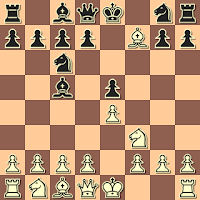Playing over the game, I was fascinated by White's "self-inflicted" backward pawn at e4 - and, apparently, Black was, too, as he quickly jumped a Knight into the created "hole".
Ah, but we should have been watching the advancing f-pawn, which spearheaded an attack which crashed on through.
A very interesting lesson!
RK -KM
Internet, 2016
1.e4 e5 2.Nf3 Nc6 3.Bc4 Bc5 4.Bxf7+
4...Kxf7 5.Nxe5+ Nxe5 6.d4 Bxd4 7.Qxd4 d6 8.O-O Ne7
9.Nc3 Rf8 10.Bg5 Kg8 11.f4 N5c6 12.Qd3 a6
Black looks comfortable. He needs to find a way to develop his Bishop, and then the Queenside Rook. Too many times the Jerome Gambit defender finds himself down those two pieces, as they remain out of action and unable to help meet an attack. Fair warning!
13.Qg3 Qe8 14.f5 Ne5
Who can argue with that wonderful Knight on e5? Fine, let him have his day of glory, but pay attention to what else is going on.
15.f6 N7g6 16.Nd5 Qd7
Not the best defensive move. Also, see the note to move 12.
17.fxg7 Kxg7 18.Rxf8 Kxf8 19.Rf1+ Nf7 20.Bh6+ Ke8
It looks like Black has missed the fact that this move will lose his Queen, but if the King had gone to g8 the Queen would soon be lost, anyhow - and the King checkmated, to boot.
21.Nf6+ Kd8 22.Nxd7 Bxd7 23.Rxf7 Black resigned





































